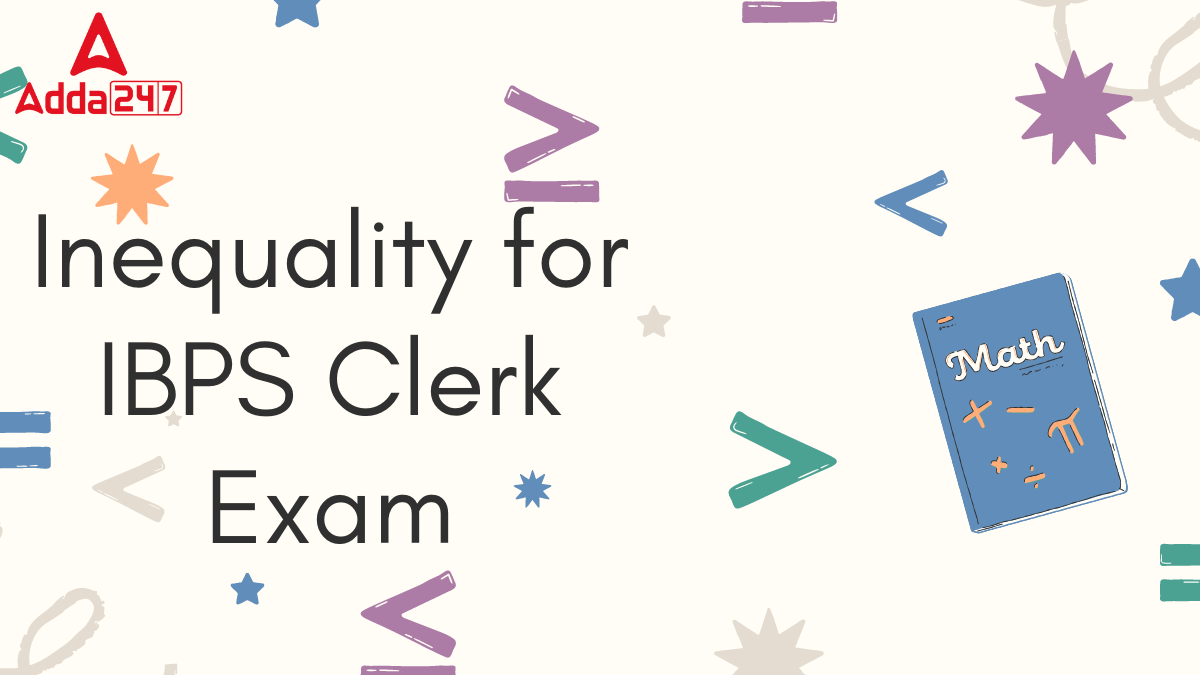Table of Contents
Inequality is a crucial topic in the reasoning section of the IBPS Clerk Exam. Mastering this topic can significantly boost a candidate’s score, as questions on inequality are relatively straightforward and quick to solve if you understand the concepts well. This article provides a detailed guide on inequality, including key concepts, types of questions, solving techniques, and practice questions.
Inequalities: Meaning
Inequality questions test your ability to compare and analyze the relationship between different variables or quantities. These questions involve the use of mathematical symbols to denote relationships between variables. The common symbols used in inequality questions are:
- Greater than (>)
- Less than (<)
- Greater than or equal to (≥)
- Less than or equal to (≤)
- Equal to (=)
- Not equal to (≠)
Types of Inequality Questions
There are two main types of inequality questions in the IBPS Clerk Exam:
- Direct Inequality: These questions involve direct comparison between two or more variables using the symbols mentioned above.
- Coded Inequality: These questions use coded symbols to represent the usual inequality signs. Candidates need to decode the symbols and then solve the inequalities.
Direct Inequality (Example)
If P ≤ Q, Q < R, and R ≥ S, then which of the following is definitely false?
a) P < R
b) S ≤ Q
c) R > P
d) S > Q
Answer: d) S > Q
Coded Inequality (Example)
If ‘A $ B’ means ‘A is greater than B’, ‘A # B’ means ‘A is equal to B’, and ‘A @ B’ means ‘A is less than B’, then which of the following is true if P $ Q @ R?
a) P is equal to R
b) P is greater than R
c) Q is greater than P
d) R is greater than P
Answer: b) P is greater than R
Inequality Solving Techniques
Inequality is a scoring topic in the IBPS Clerk Exam that requires a clear understanding of concepts and regular practice. To solve inequality questions effectively, follow these steps:
- Understand the Symbols: Familiarize yourself with the inequality symbols and their meanings.
- Simplify the Expressions: Simplify the given expressions by eliminating common terms or combining like terms.
- Compare Step-by-Step: Compare the variables step-by-step to determine the relationship.
- Use Transitive Property: Use the transitive property of inequalities (if a > b and b > c, then a > c) to simplify and solve the questions.
- Practice Decoding: For coded inequality questions, practice decoding the symbols and rewriting the inequalities in their standard form before solving them.
Inequalities Questions for the IBPS Clerk Exam
Directions (1-5): In these questions, the relationship between different elements is shown in the statements. The statements are followed by conclusions. Study the conclusions based on the given statements and select the appropriate answer. Give answer-
(a) If only conclusion I is true
(b) If only conclusion II is true
(c) If both conclusions I and II are true.
(d) If either conclusion I or II is true
(e) If neither conclusion I nor II is true.
Q1. Statements: K < Q ≤ J, B < O = N, O > M ≤ I = Q
Conclusion: I. B < I
Conclusion: II. O ≤ B
Q2. Statements: A ≥ C ≤ Z < Y, O = M < Z > X
Conclusion: I. Y > X
Conclusion: II. M > C
Q3. Statements: Z > Y ≥ R, Y ≤ J > K, J = O > Q
Conclusion: I. Q > Y
Conclusion: II. Z > O
Q4. Statements: K < Q, N ≤ J ≥ M, Q < O = N
Conclusion: I. N < M
Conclusion: II. N ≥ M
Q5. Statements: J > K < L < R < L > T < Z
Conclusion: I. K < T
Conclusion: II. T ≤ K
Directions (6-10): In these questions, the relationship between different elements is shown in the statements. The statements are followed by conclusions. Study the conclusions based on the given statements and select the appropriate answer:
Q6. Statements: N > Z ≥ Y = J ≤ K < Q ≤ B, C > Y
Conclusion: I. Y < B
Conclusion: II. C ≥ Q
(a) Both conclusions I and II are true
(b) Either conclusion I or II is true
(c) Only conclusion I is true
(d) Neither conclusion I nor II is true
(e) Only conclusion II is true
Q7. Statements: Z ≥ Y = J ≤ K < Q ≤ B; A ≥ Z
Conclusion: I. A > Q
Conclusion: II. A ≥ J
(a) Both conclusions I and II are true
(b) Only conclusion II is true
(c) Neither conclusion I nor II is true
(d) Either conclusion I or II is true
(e) Only conclusions I is true
Q8. Statements: T < I = Z ≤ H; G < I
Conclusion: I. H > T
Conclusion: II. H > G
(a) Both conclusions I and II are true
(b) Either conclusion I or II is true
(c) Neither conclusion I nor II is true
(d) Only conclusion I is true
(e) Only conclusion II is true
Q9. Statements: F < N < P ≤ R; W ≥ P; R ≥ X
Conclusion: I. N < X
Conclusion: II. W < F
(a) Only conclusion II is true
(b) Either conclusion I or II is true
(c) Both conclusions I and II are true
(d) Neither conclusion I nor II is true
(e) Only conclusion I is true
Q10. Statements: K = F < S < P ≤ T > M; W ≤ P
Conclusion: I. W ≥ F
Conclusion: II. K > W
(a) Neither conclusion I nor II is true
(b) Both conclusions I and II are true
(c) Only conclusion II is true
(d) Either conclusion I or II is true
(e) Only conclusion I is true
Q11. Which of the following expressions shows that ‘M≥O’ and ‘Z<Y’ are definitely true?
(a) M>O>B≥Z≥E>Y
(b) Z<Q≤Y<M>J≥O
(c) Y>O≥Z≥I≥M=Q
(d) Y≥I≥Z=O≤I<M
(e) None of these
Q12. Which of the following symbols should replace the sign (?) and (*) in the given expression in order to make the expression Q>X definitely false and Z>Q is definitely true?
Z (?) Y > O () M ≥ X
(a) >, >
(b) ≥, >
(c) <, =
(d) >, =
(e) None of these
Q13. Which of the following symbols should replace the sign (?) and (#) in the given expression in order to make the expressions A ≥ Y definitely true and K < P definitely false?
K < M ? A = P # Q ≥ Y
(a) ≥, >
(b) <, >
(c) >, ≥
(d) =, >
(e) None of these
Q14. Which of the following symbols should replace the sign (%) and (@) in the given expression in order to make the expressions X < M and R ≥ Z definitely true?
P>M2Q%Z = X @R
(a) ≥, >
(b) ≥, ≤
(c) >, <
(d) =, 2
(e) None of these
Q15. Which of the following expressions will be definitely false if the expression ‘A≤R<CD> E > B’ is definitely true?
(a) C > A
(b) D > B
(c) B > C
(d) E ≤ C
(e) None is false
| Solutions | |||||||||
| 01 | e | 02 | a | 03 | e | 04 | e | 05 | d |
| 06 | c | 07 | b | 08 | a | 09 | d | 10 | d |
| 11 | d | 12 | d | 13 | c | 14 | c | 15 | c |
| Related Posts | |
| IBPS Clerk Vacancy 2024 | IBPS Clerk Salary |
| IBPS Clerk Syllabus | IBPS Clerk Previous Year Papers |
| IBPS Clerk Cut Off | IBPS Clerk Handwritten Declaration 2024 |




 GA Capsule for SBI Clerk Mains 2025, Dow...
GA Capsule for SBI Clerk Mains 2025, Dow...
 The Hindu Review October 2022: Download ...
The Hindu Review October 2022: Download ...
 World Malaria Day 2025
World Malaria Day 2025



